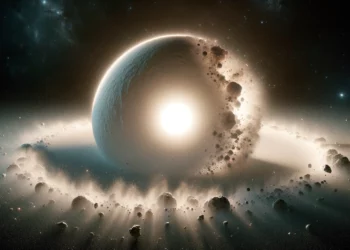Years of observation have finally paid off as a team of Polish astronomers have captured an incredibly rare event from start to finish: a white dwarf going nova.

White dwarfs are very dense stellar remnants, without any fusion taking place inside of them. They are thought to be the final evolutionary state of stars whose mass is not high enough to become a neutron star, and it’s estimated that 97% of all stars in the Milky Way will eventually become such a star.
In order for a white dwarf to go nova, you usually need a dual system – a regular star and a white dwarf sucking its hydrogen until it eventually goes ‘boom’ in a huge white flash. In the case of V1213 Cen (aka Nova Centauri 2009), astronomers got lucky. They observed the system from 2009 when the explosion happened, being able to study the entire nova process from start to finish. The rarity lies herein, as we usually miss the start of such explosions.
“When novae or supernovae go off, they are usually followed up with many telescopes, and therefore we know a great deal about the ‘after’ of these explosions,” Carles Badenes, an astronomer at the University of Pittsburgh, who was not involved in the study, told the Verge. “But it is of course very hard to know…which star is going to do something interesting, so the ‘before’ is very much a mystery.”
Unlike a supernova, both stars can survive a nova. However, the process takes a very long time to shape up.
“From time to time such systems undergo large-amplitude brightenings. The most spectacular eruptions, with a ten-thousandfold increase in brightness, occur in classical novae and are caused by a thermonuclear runaway on the surface of the white dwarf,” the authors wrote in the study. “Such eruptions are thought to recur on timescales of ten thousand to a million years.”
But in the meantime, the data is being used to refine the so-called hibernation model – the theory that nova explosions are intertwined with periods of hibernation, in which the dual star system lies dormant. The white dwarf is now in a hibernation stage, but it’s considerably brighter than it was before the explosion. This would suggest that there will be another explosion, though sometime in the next couple of million years.
“Within the six years before the explosion, the system revealed dwarf nova outbursts indicative of a low mass-transfer rate. The post-nova is two orders of magnitude brighter than the pre-nova at minimum light with no trace of dwarf nova behaviour, implying that the mass-transfer rate increased considerably as a result of the nova explosion.”
Journal Reference: The awakening of a classical nova from hibernation.






